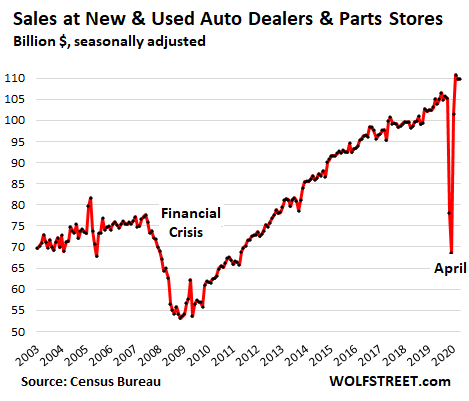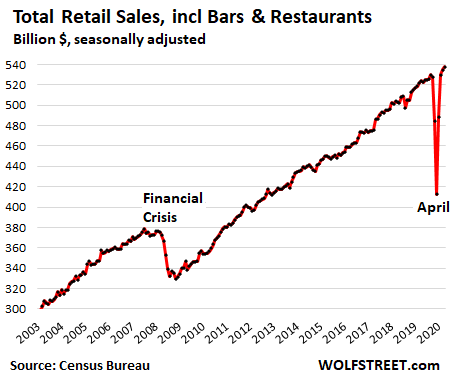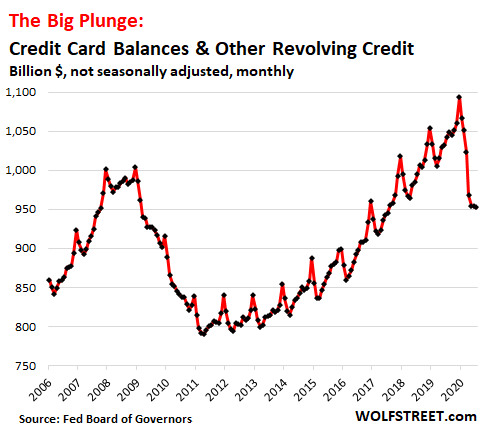How Life Changed During the Pandemic: Still Loaded with Stimulus Cash, Americans Went Shopping. But Where?
by Wolf Richter, Wolf Street:
 Illustrated with 13 whiplash-inducing charts.
Illustrated with 13 whiplash-inducing charts.
Total retail sales in August inched up by 0.6% from July, to a new record of $538 billion (seasonally adjusted), according to Census Bureau data this morning. It was the second month in a row of only slight upticks, after big bounce-backs in May and June, from the plunge in March and April. Compared to August 2019, total retail sales were up 2.6%, not adjusted for inflation, with large differences in various categories, from restaurants to auto sales, and we’ll get to those in a moment:

Powered by stimulus.
Consumers received the stimulus checks of $1,200 per taxpayer and $500 per child, starting in April, and those who were on state or federal unemployment insurance received the extra $600 a week in federal top-off money, which expired in July, and now many of them are receiving the extra $300 a week that started in August.
But the extra $600 a week and now the extra $300 a week don’t necessarily arrive one check a week. There has been a backlog in processing these claims, and suddenly consumers receive lump-sum payments to cover weeks of claims. For example, California started sending three of the $300-a-week in extra money as $900-lump-sum payments starting on Labor Day. Recipients might not get any unemployment for weeks, and suddenly they get a catch-up payment of thousands of dollars.
And what did they do with it? Similar to the stimulus money in April, many people used these funds to pay down their credit card balances and other revolving credit, which have dropped by nearly 10% from February through July, including the biggest plunge on record in April when the stimulus checks arrived. Credit card balances are now back to levels first seen in 2008:

People created room on their credit cards and then they spent these funds more or less gradually by charging up their credit cards again.
Other people used these stimulus and extra unemployment funds for down-payments on a car. In addition, this summer few people flew to go on vacation – with air passenger traffic still down about 70% in August from a year ago, and others didn’t go to the dentist and delayed other healthcare spending.
In addition, over 7% of all home mortgages are still in forbearance, and homeowners don’t need to make mortgage payments and can spend that money elsewhere. And eviction bans have given renters some leeway in how to spend their money, shifting some rent payments to retail and other categories.
In other words, the stimulus and extra unemployment money didn’t all get spent in the month during which the government sent it. The spending was spread out over time, and spending priorities shifted in massive ways, and went in bursts, such as sporting goods, some of which then faded.
Retail sales by category.
Sales at new & used auto dealers and parts stores were essentially unchanged in August, compared to July, and just a hair off the record in June. At $109.8 billion (seasonally adjusted) the largest category in retail sales, they were up 4.5% from August last year.
These dollar-sales come amid still sharply lower unit sales. In August, new vehicle sales in units were down 15% year-over-year, and used vehicle retail sales in units were down 2%. This disconnect between rising dollar sales and still-down unit sales is driven by two factors:
Price increases that were particularly sharp in used vehicles; and demand for expensive new vehicles, such as higher-end pickups and SUVs. The average transaction price of new vehicles across the industry in August jumped by 7% year-over-year, according to J.D. Power estimates, reflecting price increases and a larger proportion of high-end units in the sales mix, in line with the “K-shaped” recovery:

Sales at “Non-Store Retailers” (mostly ecommerce) ticked up a smidgen from July after having spiked during the months when many brick-and-mortar stores were closed, and when consumers switched to ecommerce for items even when stores were open, such as groceries. Sales of $83.1 billion in August (seasonally adjusted), the second highest ever after the record in May, were 22.4% higher than in August last year.



